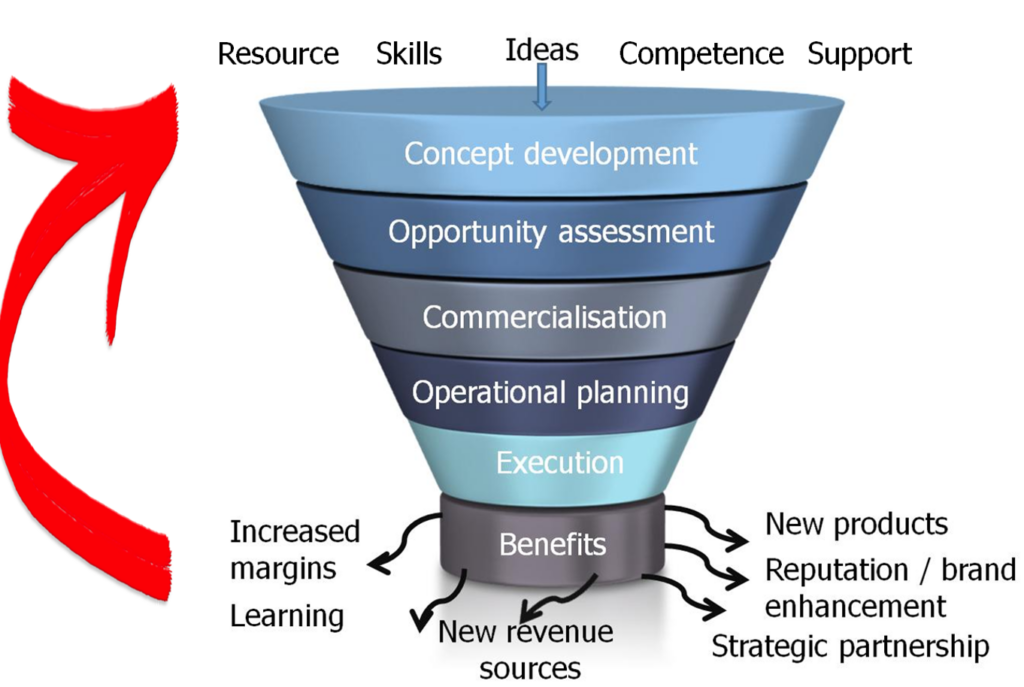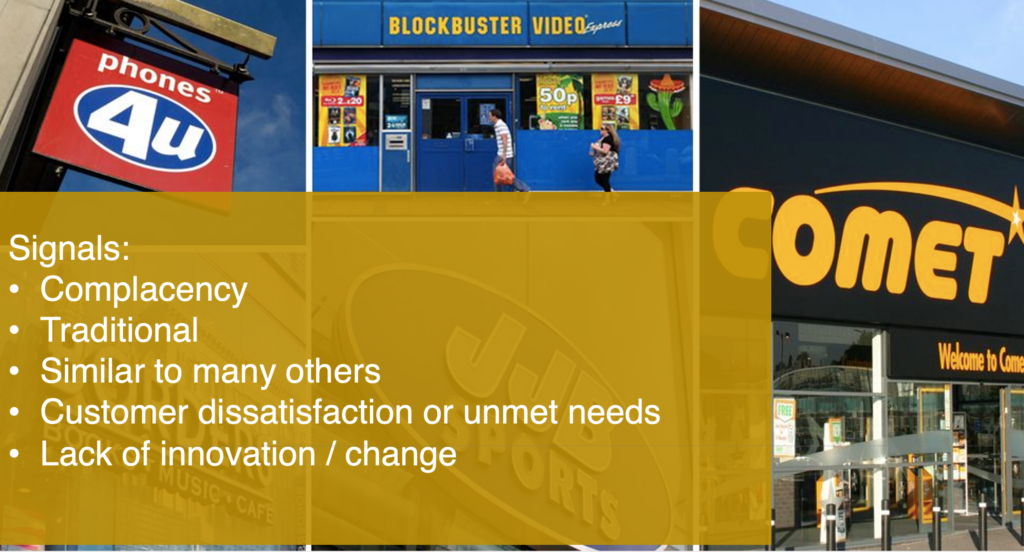Posted in Blog, Innovation, Innovation Culture by Jo North
What is business innovation, and why is business innovation important for your business right now?
If you think innovation is for ‘those businesses over there’, then I’m hoping to change your mind on that, as well as give you some tips along the way that will help you out.
What is Business Innovation?
Innovation a word that we use all of the time, but it’s not anything new. It’s something that has novelty, it could be an idea or a product, but it’s all about creating value.
Business innovation is about…
- Being customer or user-focused
- Solving a problem that matters to your customers
- Identifying and following through on an opportunity
- Purposeful creativity
- Changing the way things have been done
- Taking an idea on the journey through to commercialization
- Testing, learning, and retesting to get feedback quickly and to accelerate and de-risk progress
- Developing a business case and being clear on the potential return on investment for your innovation
- Having a growth mindset, and appreciating that not everything will work out as expected

Business innovators need to demonstrate and use these skills:
- Creativity
- Critical thinking
- Analysis
- Strategic thinking
- Problem solving
- Communication and influencing
- Team working
- Resilience
- Perseverance
- Commercial acumen
Business Innovation is about Creating Value
Innovation is about creating value.
Value is one of those words we use all the time as well, but what do we mean by value? We’re all in business to solve somebody’s problem somewhere. The problem could be a small one, it could be a big one.
The problem could be that somebody wants to treat themselves and we are there to help them find the thing they want to treat themselves with. The word value is actually quite hard to define, precisely because it has multiple layers of meaning. I like to think about it in three layers.
The Three Value Layers
- The regard and the esteem that we hold something in.
- How important we perceive something to be.
- A standard, such as our:
- Values
- Judgment of what’s important to us.
- A number
- something that we can quantify.
When we’re innovating, what we’re doing is we’re finding new creative solutions that provide value on those three levels for our customers. They may be internal or external customers, they may be both, but the end user is getting some value from it, and from a business perspective, they’re happy to pay for it.
Business Innovation Triggers
What triggers business innovation?
New technology brings new possibilities, which creates an opportunity for more innovation. There might be a need to find a solution. Having a problem or an unmet need can drive innovation. We’ve seen that with COVID vaccines. They didn’t exist before the Covid pandemic, but then the need arose for the vaccine and now we have them available to us.
Continuous improvement is the need to continually be bettering ourselves and staying competitive.
Sometimes something happens in the market that forces everything else to change. We call this disruptive innovation. There could be dissatisfaction with the status quo. It could be driven by a change in the customer’s needs. All of those things are super connected into each other. But they’re all triggers for innovation.
YOU drive innovation! You are a super creative genius! In your brain you have trillions of data points from all your experiences, all the things you’ve seen, heard, read, tasted, felt and sensed. All that data is what drives your ideas. Read about how to be more creative in my article here.
Your ideas are when two thoughts come together for the first time, and, you need an idea at the basis of every innovation. That's where it all starts! Share on XTypes and Levels of Business Innovation
Innovation is usually driven from something. It could be a product innovation, or service innovation.
A product innovation is different from a service innovation in that a product is tangible. It’s something you can hold you like a phone, you can touch and feel it. A service is intangible, it is something that you experience, and then it’s gone. You can find out more about product innovation and product lifecycles in my article here.
You also have process innovation where you’re trying to do things more quickly, efficiently, with better quality and continuously improving your process.
Business model innovation is where you pivot to restructure how your business ‘does business’. We’ve seen a lot of business model innovation through the COVID lockdown. For instance, restaurants and food outlets have turned more to takeaways and deliveries. Find out more about how to pivot in my article here.
Communication is another thing that we can innovate. How we communicate our marketing can be innovated. We can stand out simply by the way we speak to people, by our packaging, and through the way we brand ourselves.
Culture can be innovated as well. Deciding that we’re going to create a special culture within our organization that’s going to make a difference.
The Business Innovation Iceberg
Innovation doesn’t have to be a game changing thing that is massively disruptive or overly fantastic. Most innovation is like an iceberg. It’s incremental, it’s the tiny changes that matter and all add up to create continuous improvement.

Another type of innovation is differential innovation. This is what we see in businesses that’s just above the surface. Differential innovation is doing something to stand out from the competition, having a better product or service, something new and improved, something that’s distinctive and that helps us stand out from the competition.
And radical innovation is that game changing stuff, that triggers the type of change that forces a whole sector or industry to respond, like Uber or AirbNB.
Looking at Innovation in Numbers
– about 85% of innovation is incremental
– about 14% is differential
– only 1% of innovation is radical.
Don’t think that innovation just means doing big, game changing things. It doesn’t! It’s all valuable and all important.
You’re Always Innovating!
If you’re wondering where and how to begin, it may help to realize that you’re always innovating! If you have ever thought of a product or service, launched a business, or you’re doing things in a business that you are continually growing, you are innovating!
Business Innovation is a Process
Innovating is about putting your ideas into action, having the skills, the competency, the resources, and the support for those ideas and then working out which ones are important and shaking them through the funnel. And when you do that, you reap the benefits of innovation such as:
- New products
- Improved reputation
- New revenue sources
- Increased margins, and so on.
However, sometimes, in innovation, it’s all about getting it wrong and learning from that. Even sometimes deliberately getting things wrong (safely!) just to see what happens.

Financial Considerations of Business Innovation
It’s important that any innovating that you do fits with your business, your portfolio, your capabilities, that it synergizes with other things that you do so that it is really adding value to your portfolio.

Also consider the economics. Have you got the cashflow to sustain your business innovation? You may need investment and sometimes, you need to wait to get that cash back in. All of that needs to be considered.
Build, Measure, Learn
Innovation isn’t about waiting for the perfect solution or getting the perfect answer or the perfect product or service. It’s better to build something and put it out there. Test it, learn from it, and then do it again. It’s a process of build, measure and learn, and we’re doing this very quickly and at a low cost.
You may want to think about it this way. You’re always in beta testing mode. Everything is always being developed.
If we try and develop the perfect solution and we take too long doing that, by the time that solution is complete it’s no longer relevant, and that can be a very expensive mistake to make.
Instead, if you take small steps, do a bit, test it, and repeat that, you are likely to get to where you want to be faster and with less risk. You’ll also get a much better innovation along the way, because you’ve been implementing all the things that you’ve been learning in the process.
Ripe for Disruption
Look for a space that’s ripe for disruption, that needs innovating. Also, ask yourself if you are in a space that might be ripe for disruption, What you want to look for are businesses that are:
- Complacent
- Traditional
- Like everybody else
And where
- Customers aren’t completely satisfied, but there’s no nowhere else to go.
- There’s a lack of innovation, and change.

Fourth Industrial Revolution
We are in the Fourth Industrial Revolution.
If you’re using Facebook, Google, LinkedIn and so on, they are all powered by artificial intelligence (AI). The AI in these platforms learns from your behavior, what it is you want, and then gives you more of it.
Satellite technology drives geolocation used in many industries generating heaps of data.
Wearable tech creates more data, as do robotics and the ‘Internet of Things’. The Internet of Things is where you have an object, such as an appliance, and you connect it through the internet and control it through there. My favorite one is the Hive Central Heating app that we have at home. This app enables us to adjust the temperature up and down through our mobile phones. My husband turns it down, and I turn it up!
This new technology is all around us, we’re immersed in it, this isn’t coming, it’s already here! Businesses need to tap into that, not just from a customer facing side of things, but also back of house as well. There are many different apps and technologies, many of which are quite affordable, that we can use to help us gain efficiencies in our businesses.
And thinking about the future, don’t get stuck always looking back. What happened yesterday doesn’t necessarily mean that something similar will happen tomorrow. After 2020 and 2021 so far, I think we’re all sensing that there’s a lot of change, and the future isn’t as predictable and consistent as we thought it might have been. As a result, we need to be innovative and build resilient businesses that are adaptable to change, even when we don’t know what that change will be.
Disrupt or be Disrupted
So, my message is to disrupt or be disrupted. What I mean by this is that if you’re not innovating, if you’re not driving your business forward, then somebody else will disrupt the market and you’ll have no choice other than to move forward and work out how you’re going to respond. So instead, be on the forefront and stay tuned in to what’s going on in the world around you. Knowing your customers, what they need, is super important.
So go for it! You be the disrupter. And I’d love to hear how you might do that in the comment section below. Tell me, have you innovated over recent months? Do you have any big ideas that you’re working on for the future? Let me know because I would absolutely love to help you with that. And of course, you can find lots of free resources that will help you on bigbangpartnership.co.uk/resources.

